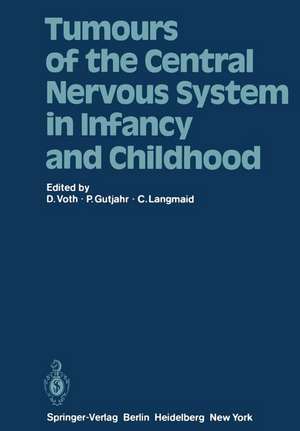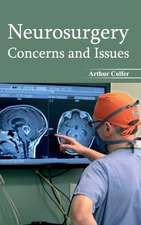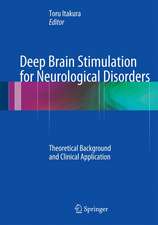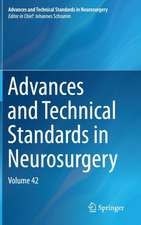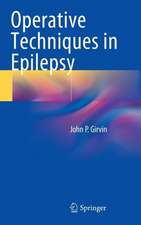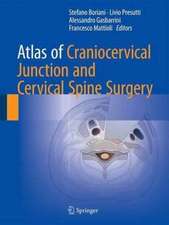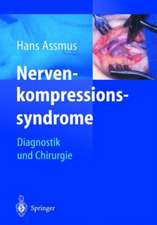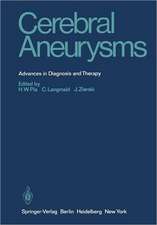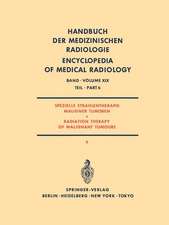Tumours of the Central Nervous System in Infancy and Childhood
Editat de D. Voth, P. Gutjahr, C. Langmaiden Limba Engleză Paperback – 12 feb 2012
Preț: 728.52 lei
Preț vechi: 766.87 lei
-5% Nou
Puncte Express: 1093
Preț estimativ în valută:
139.40€ • 145.94$ • 115.35£
139.40€ • 145.94$ • 115.35£
Carte tipărită la comandă
Livrare economică 05-19 aprilie
Preluare comenzi: 021 569.72.76
Specificații
ISBN-13: 9783642954153
ISBN-10: 3642954154
Pagini: 464
Ilustrații: XX, 440 p.
Dimensiuni: 170 x 244 x 24 mm
Greutate: 0.74 kg
Ediția:Softcover reprint of the original 1st ed. 1982
Editura: Springer Berlin, Heidelberg
Colecția Springer
Locul publicării:Berlin, Heidelberg, Germany
ISBN-10: 3642954154
Pagini: 464
Ilustrații: XX, 440 p.
Dimensiuni: 170 x 244 x 24 mm
Greutate: 0.74 kg
Ediția:Softcover reprint of the original 1st ed. 1982
Editura: Springer Berlin, Heidelberg
Colecția Springer
Locul publicării:Berlin, Heidelberg, Germany
Public țintă
ResearchCuprins
1 Basic Research and Special Pathology.- Intracranial Tumours of Infancy and Childhood.- Remarks on the WHO Classification of Tumours of the Central Nervous System.- Developmental Neuro-Oncogenesis in Experimental Animals.- Brain Tumours and Genetics.- Interferon and Antitumour Effects.- Rare Intracranial Tumours in Infancy and Childhood.- Intracranial and Spinal Tumours in Newborns and Infants.- The Usefulness of Immunocytological Demonstration of Glial Fibrillary Acidic Protein for Diagnostic Problems of Cerebral Tumours.- CNS Tumours in Infancy, Childhood, and Adolescence.- Congenital Intracranial Teratoma in a Newborn.- Discussion.- 2 Clinical Presentation, Diagnosis, Follow-Up Studies.- Clinical Presentation of Space-Occupying Lesions of the Central Nervous System.- Cytology of Cerebrospinal Fluid in Children with Brain Tumours.- Electrophysiological Diagnosis and Follow-Up Controls in Cases of Tumours of the Optic Chiasm.- Electroencephalograms in Long-Term Survivors of Primary Intracranial Tumours of Childhood.- Early Auditory Evoked Potentials (EAEP) in Children with Neoplastic Lesions in the Brain Stem.- Conventional Investigations of CNS Tumours in Children.- Computer Tomographic Diagnosis of CNS Tumours in Childhood.- Radionuclide Imaging of Cerebral Tumours in Children.- Follow-Up Studies of Brain Tumours in Infants and Children.- Computed Tomography and/or Ventriculography?.- Ventriculography as a Diagnostic Procedure in CNS Tumours in Childhood: Its Indications and Interpretation.- The Diffuse Brain Stem Astrocytoma in Childhood: Morphology, Course, and Prognosis.- Astrocytoma with Extracranial Metastases.- Diktyoma (Medulloepithelioma). A Rare Neuro-Epithelial Tumour of the Eye.- Intracranial Teratoma of a Newborn. Computer Tomographic and Morphological Findings.- The Isolated Fourth Ventricle: Review of Current Concepts and Report on Three Cases in Children.- Follow-Up Findings with CT Scan and Ventriculography After Radiotherapy of Inoperable Midline Tumours in Childhood.- Discussion.- 3 Surgical Treatment.- Evolutional, Developmental, and Clinical Aspects of Brain Stem Organisation.- Standard Techniques and Microsurgical Procedures in the Removal of Supratentorial and Infratentorial Tumours.- Additional Operative Procedures (Shunt Systems, Leksell and Torkildsen Drainage).- The Significance of Continuous Recording of Intracranial Pressure in Children with Brain Tumours.- Preoperative and Postoperative Intensive Care and Oedema Therapy.- Therapy of Peritumoural Brain Oedema.- CT-Sterotactic Biopsy of Brain Tumours.- Diagnostic Potential of Stereotactic Biopsy of Brain Tumours. A Report of 400 Cases.- Internal Shunt or Perioperative Pressure-Controlled Ventricular Fluid Drainage (C-VFD) in Children and Juveniles with Infratentorial Tumours.- Indications and Experiences with the Ommaya-Reservoir for Treatment of CNS Neoplasms in Childhood.- Indications for the Trans-Sphenoidal Approach to Craniopharyngioma Operations in Youth and Childhood.- Which Considerations Determine the Choice Between the Subfrontal and Trans-Sphenoidal Approach to Tumours of the Sellar Region in Youth and Childhood?.- The Influence of Different Antihypertensive Drugs on Intracranial Pressure.- Ventriculocisternostomy by the Method of Leksell — Indications, Technique, and Results.- Discussion.- 4 Radiotherapy.- The Radiosensitivity of the Infant Brain.- Radiation Technique and the Planning of Treatment in Brain Tumours in Children.- Experiences with the Treatment of Cystic Craniopharyngiomas by Stereotactically Injected Radioisotopes.-Radiosurgery in Intracranial Tumours and Arteriovenous Malformations in Children.- Radiation Therapy in the Treatment of the Astrocytomas and Midline Tumours of Childhood.- Radiotherapeutic Principles in the Combined Treatment of CNS Tumours in Children.- Postoperative Chemotherapy Prior to Radiotherapy in the Combined Treatment of Medulloblastoma, Ependymoma and Tumours of the Pineal Region: Early Results.- Radiotherapy of Medulloblastoma: Radiation Technique, Results, and Complications.- Report on the Medulloblastoma Study of the Society of Paediatric Oncology — Present Position.- Data on the Biology of Medulloblastomas.- Treatment of Meningeal Malignancy with Intrathecal 198Au-Colloid and Methotrexate. The Example of Acute Lymphoblastic Leukaemia (ALL).- Infratentorial Tumours — Treatment and Results in 109 Children.- Discussion.- 5 Chemotherapy, Late Effects, and After-Treatment.- Cytostatic Monotherapy of Tumours of the Central Nervous System in Children.- Rationale of Combined Chemotherapy of Brain Tumours.- Acute Toxicity of Chemotherapy of Tumours of the Central Nervous System in Children.- Late Effects After Treatment of Brain Tumours in Childhood.- Development After Treatment of Cerebellar Medulloblastoma in Childhood.- Spongioblastoma in Childhood. Remarks on Problems in Diagnosis and Treatment.- Medulloblastoma. Relationship of Histologic Type to Survival.- Ophthalmological Findings in Long-Term Survivors After Primary Brain Tumours in Childhood.- Endocrinological Investigations in 68 Children with Brain Tumours.- Supratentorial Tumours in Infants and Children.- Discussion.- Final Comments and Summing-Up.
